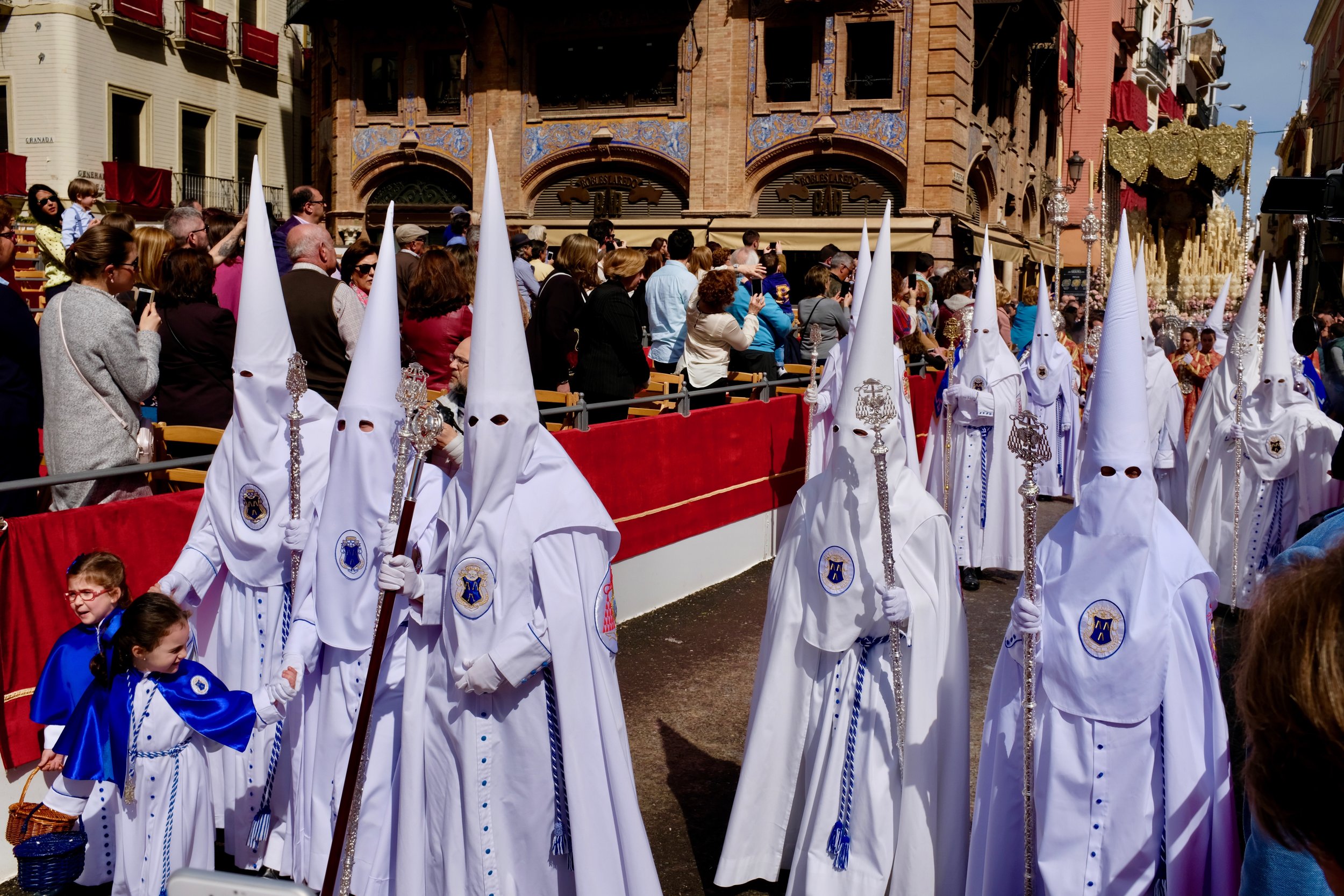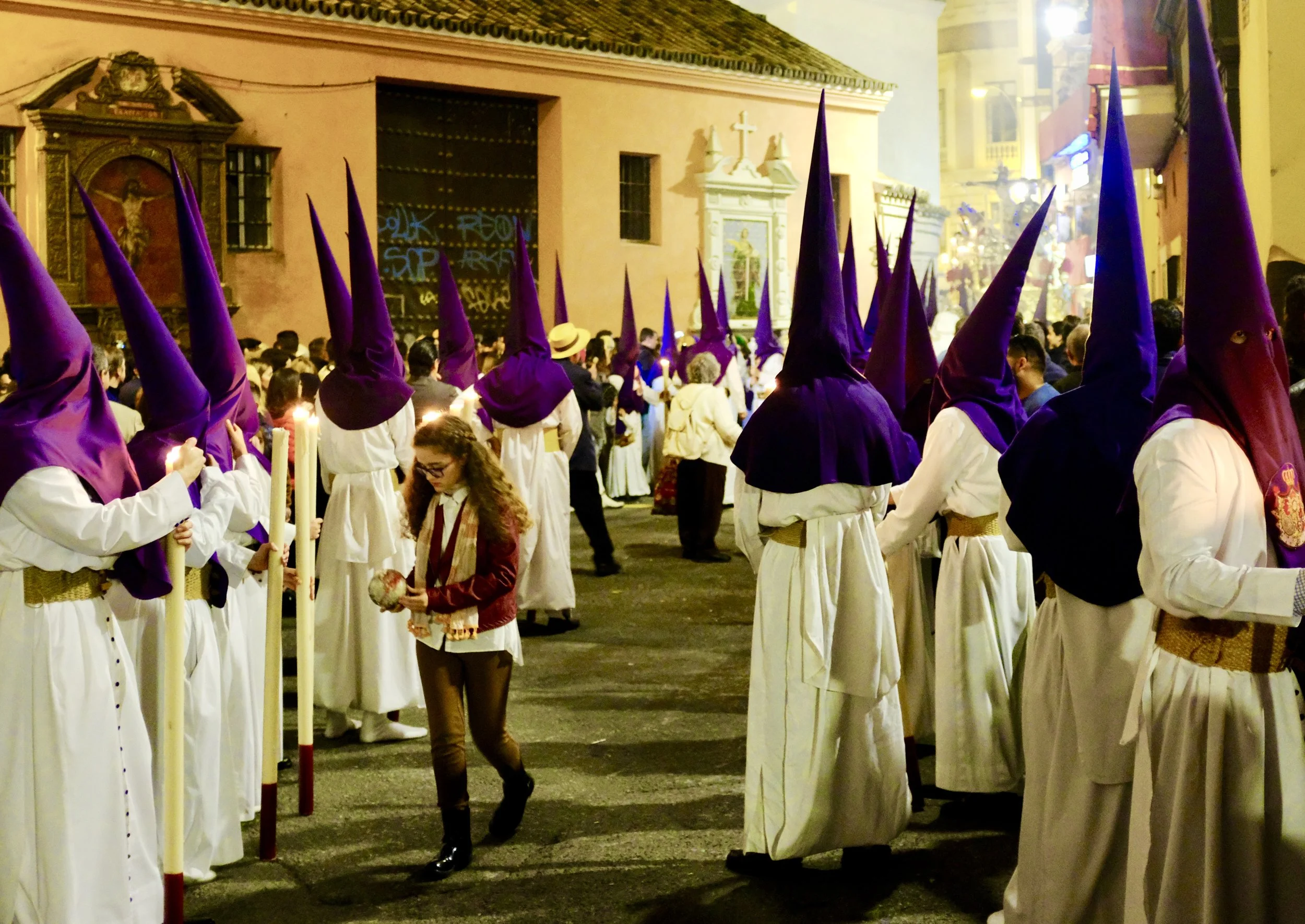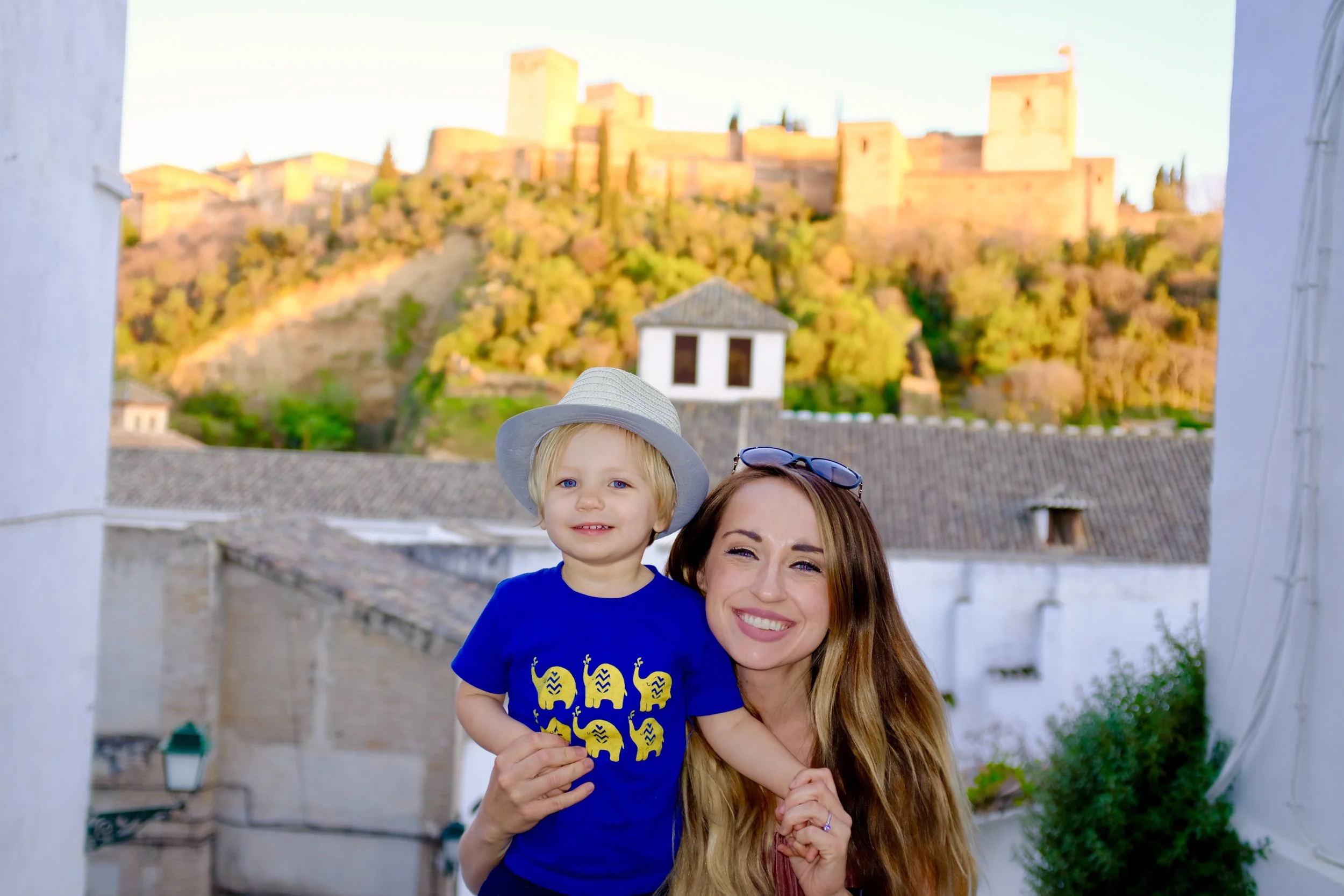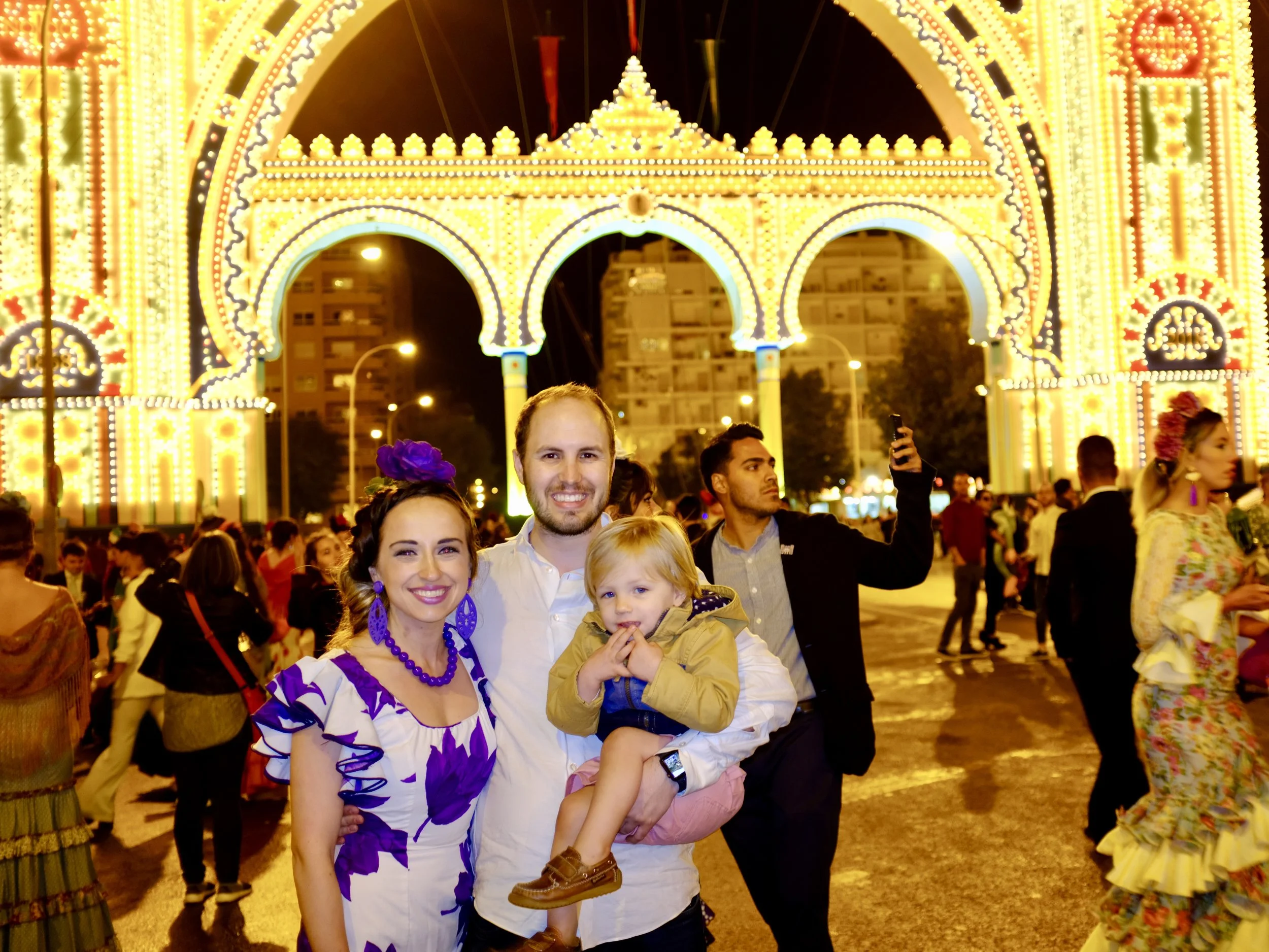Semana Santa in Seville, Spain – My First Spanish Holy Week
The locals say the best time to visit Seville is during the month of April. This is because April is typically the month of the two major Spanish festivals – Semana Santa and Feria de Abril. While the Feria is all about fun, family, and dancing the night away in Flamenco dresses, (check out my post here and here about the Feria) Semana Santa is more spiritual and serious. Semana Santa is a religious festival that lasts 7 days, starting on Palm Sunday and ending on Easter Sunday. It's a week full of processions that go throughout the city of Seville and run during the day and into the evening, some lasting all night. Many people of Seville love Semana Santa and look forward to it all year. There are Semana Santa processions that go on all throughout Spain, but arguably the one in Seville is the most popular, the most important, and the most grand. People all over Spain and from around the world gather to Seville during this time, making Seville a very crowded and busy place. In 2019, Semana Santa will occur between April 14th - April 21st. Book your tickets now to see it for yourself. There are so many different aspects that make up Semana Santa and the amazing festival that it is. Here are some of the major ones listed below with a brief explanation and pictures about each one.
The Brotherhoods / Nazarenos
Many of the churches in Seville (there are 115 churches in total) have their own brotherhoods that have been around for, in some cases, hundreds of years. A brotherhood is similar to a social club, like a Masonic Lodge in the United States, that you can choose to join and be religiously dedicated to for life. The people within the brotherhood that march in the processions are called Nazarenos. Some brotherhoods are small with about 300 members, while others are very large with about 3,000 members. Each brotherhood gets one scheduled time to march during the week of Semana Santa. Sometimes a procession might have to be cancelled at the last minute due to bad weather, which is very disappointing to that particular brotherhood because there is not enough time to reschedule. The Nazarenos dress a particular way for Semana Santa. Some people are alarmed by the dress because it is drastically similar to the dress of the KKK in the US, but don’t be scared – there is no association whatsoever between the two traditions.
Many of the Nazarenos dress in a long robe and a tall pointy hat that covers the face with two holes cut out for the eyes. Every brotherhood’s dress is similar but differ in color. Some are all black, some all white, and some have two different colors like white and blue or white and purple. When Sevillians see particular Nazarenos dressed up for Semana Santa, they know right away which brotherhood they are apart of by the color of their dress. Even the children dress up in this attire for the processions. About 30 years ago, some brotherhoods started allowing females to join in as well which was a huge change. About 7 years ago, all of the brotherhoods finally allowed females in when the archbishop of Seville put an end to gender-based discrimination completely. Now, people of all genders and ages march together in the parade as one brotherhood with one cause. 40% of the current membership is female. Often times those marching feel like doing so allows them to repent of their sins and make positive changes in their lives. The particularly devout ones often times walk barefoot in the procession.
The Christ Paso
Every brotherhood has its own Christ statue (some churches have two) found in their church that turns into a float during the week of Semana Santa. The floats are called, Pasos. They are huge, very heavy, and beautifully decorated. I was amazed at how elaborate they are with their gold color and detailed carvings. They are heavily adorned with candles, flowers, and fabric.
We had the opportunity to attend everyday of the Semana Santa and participate in many of the activities. Growing up in a religious home, I found the chronological order of the Christ pasos very fascinating because of their progression that aligned with Christ’s life as told in the Bible. The first few Christ floats that I saw were of him before the crucifixion – him being scorned by the people while wearing a crown of thorns or preparing to be whipped bare backed. There were depictions of Christ being judged by Pilate, him carrying his own cross, and him actually nailed to the cross. Easter Sunday, while much less popular for many people to attend the processions, was the most powerful day for me because we saw the resurrected Christ alive and standing with his arms extended out, greeting the world and proclaiming his resurrection. Each float told a new story of his life and his death as taught in the Bible, and it was fascinating to see the story unfold right before my eyes from beginning to end.
"El Silencio," the silent procession of Seville's Semana Santa.
My Favorite Brotherhood
We watched so many parades that week that some of them start to jumble together in my mind. However, there is one that specifically stands out and made a huge impression on me – El Silencio. El Silencio is the oldest existing brotherhood, forming in 1340. This brotherhood’s procession always happens on Good Friday late into the evening, around 2 AM. Part of their route goes down the street, Calle Silencio, a street in Seville named after this brotherhood. We debated whether to go or not since we have our toddler son, Jimmy, who needed sleep. In the end, we decided that we aren't often in Seville for Semana Santa, and that we needed to take advantage of this opportunity while we could, so we went. All three of us went, including our tired toddler, who survived fine in the end because of his planned late nap.
All of the processions are super loud with a band playing music and people talking and cheering. Not El Silencio. Silencio means “silence,” and silent it was. As we stood there waiting for this procession to come through, people were busy chatting away, then suddenly all of the noise stopped. You could of heard a pin drop; it was that silent. Jimmy cried out a couple of times to our embarrassment - for which we were not judged because Spanish culture is very welcoming and accommodating toward children - but then was mostly silent for the rest of the time, thank goodness. (Thank you iPhone and toddler games.) Then suddenly, we see it – the Christ statue coming down the street. Christ is carrying the cross and struggling to hold up the weight. People standing around me were tearing up as they saw him come through in the silence. The silence reminded me of how alone he was during this time and how difficult it was for him. Even on this float, Christ is physically alone. It was so powerful. This night of Semana Santa will be etched in my memory forever.
The Virgin Mary Paso
The second paso of each church and brotherhood is of the Virgin Mary. The Virgin Mary is often portrayed looking very sad with tears coming down her face mourning the death of her son, Jesus. There was so much emotion in all the Mary pasos, and you could really feel it as each one passed by you. While the Christ paso is done in gold, the Virgin Mary statue is most often done in silver. The candles are very elaborate on these floats. The candles are very tall and line the front side of the pasos in several stacked rows. Seeing it at night was incredible because all the candles are lit, making the float glow. I enjoyed all of Semana Santa, but seeing the processions at night was my absolute favorite.
The Route
Every brotherhood has a specific route that they walk along during their procession. Each route is specifically mapped out and planned. (Make sure to pick up a map of all the procession routes. The map also identifies the dress of the different nazarenos, telling you which brotherhoods they belong to.) Streets, schools, and businesses are closed down. Traffic is stopped. It’s a week long vacation for the whole family. The processions walk from their home church, wind through the streets of Seville, and then head towards the Cathedral of Seville, before they make their way back to their home church. Each brotherhood’s total route time differs, depending upon how far away they are from the Cathedral. El Cerro is the church that is farthest away from the cathedral, taking it 14 hours to complete a route through the city! On the other hand, El Calvario is considered the shortest procession, and only takes 4 hours to complete.
One of the best parts of watching these processions was seeing the floats entering and exiting in and out of the Cathedral de Sevilla. The Cathedral opens its massive doors allowing the floats to go through. The crowd cheers wildly as each float passes through successfully because it isn’t a simple task. On Easter Sunday, we were at the Cathedral de Sevilla to see the last brotherhood of the week, El Resucitado, with the resurrected Christ paso. When it exited out of the Cathedral doors, it was actually quite emotionally moving. Seeing all the crowds cheering and smiling as it exited the building with the resurrected Christ on top, was quite the experience, and one that I hope every traveler gets the chance to enjoy.
The Costaleros
For me, the most shocking part of Semana Santa was realizing the pasos are carried by volunteer local men that are members of that brotherhood who are called in Spanish, costaleros. Carrying the pasos is not an easy feat to master, so these men practice for several months or longer to prepare for this honor during this special week. The costaleros, hidden from view, stand under the enormous float and rest it on the back of their necks. There can be anywhere from 20-50 men under one float depending upon the size of it. Because of the length of time of each procession, the costaleros switch out every hour to give each other a break. Their switch is barely noticeable to the public eye because they do it so quickly and efficiently without disturbance. Just think how much practice that would take to walk smoothly together as one unit, to lift and turn those giant floats through the narrow cobblestone streets of Seville. The pasos can weigh over a ton! Just imagine, “Left, right, left, right! Turn! Left, right, left, right! Down!,” etc. It amazes me what a task that would be! Unfortunately even with all of the hours of practice, there are still some injuries that occur every year. The local hospital in Sevilla opens up a wing just for costalero injuries during the week of Semana Santa. These men sacrifice themselves and perform a physically draining job to honor their religion and their brotherhood.
I got to see the costaleros work first hand as we watched several parades pass from the very front row. We were so close a few times that we could actually touch the paso as it went by. Some Sevillians believe that if you touch the paso that you are forgiven of your sins and cleansed. The costaleros wear a special headpiece to protect themselves with a padded area around their neck for the paso to rest on. When the men switch out, they are sweating bullets and looking so tired, quickly sipping some water or a beer to quench their thirst. How they worked together reminded me of a flock of birds working together to fly in a V shape – each man taking turns in their designated spots, working together as one unit to accomplish a hard task. After walking a little while, all of the men, working together in one quick movement, put the paso down on the ground for a break. They stay crunched underneath it, resting. Everything is still. Then a couple of minutes later, they all lift it back up again simultaneously and the crowd goes wild.
Here is a picture of me with a group of the costaleros behind me who are taking their break before their next shift to carry the paso.
The Details
There is so much detail put into each procession. I love these up close pictures that my husband Nate shot, because they really allow you to see how intricate and elaborate each float is. There is nothing simple about them. Each carving and detail symbolizes something and is purposely there, which fascinates me. Each float is absolutely stunning and so interesting to examine up close.
The Music
All of the brotherhood processions have a band that plays and walks along the route. (Except for El Silencio) Their music is fantastic and really makes Semana Santa memorable. The music was so loud that we could hear it from our terrace at our apartment and even inside our apartment at times. During that whole week we heard the traditional songs being played over and over again. At the time we thought it was a bit of an annoyance, but now I realize how special it was and wish I could hear them again from my window. Just maybe not while Jimmy is trying to sleep . . .
The Crosses
At the start of every procession is a giant cross, called, “The Great Cross,” that is held by one of the nazarenos within that brotherhood. They hold the cross to show that they are the start of a new procession of a new brotherhood. That first cross is huge. It looks so heavy! I am surprised that one nazareno is able to hold it as long as they do.
Later on in the procession after the band, come the penitentes, carrying large wooden crosses. These crosses aren’t as large as The Great Cross that starts the procession, but they are still very big. The penitentes wear the same color dress as the nazarenos earlier in the procession but their hoods are different. The nazarenos have pointed hoods and the penitentes have hoods that are drooping down. The penitentes are there to show their penance – a voluntary outward expression of repentance, showing the world that they have done something wrong.
What to Eat?
During the holy week, all of the bakeries around town make two special treats that are only found during this time of year. The first one is called, Torrija. It is a small piece of fried bread that is soaked in a sugary honey and cinnamon syrup. You eat it with a fork. It is somewhat similar to french toast in style. The bread is so drenched in the syrup that the bread becomes a thick gelatin in the middle. We tried torrijas from many different bakeries around town that week, but our favorites were from La Campana. I dare you to eat just one. (Click here for my list of the best dessert and pastry shops in Seville, including La Campana.)
The second famous treat that you have to try during the Easter season is called, pestiño. It is a sesame seed based dough that is formed into a twist shape, fried, and then glazed in honey. You eat it with your hands, and it is completely delicious. They can also be found at La Campana, as well as many other pastry shops around the city of Seville. Go try them, and enjoy them while you are watching one of the processions.
As I stood there with my small family of three watching these processions go by, it hit me how lucky I was to be witnessing them in person for myself. This religious holiday of Semana Santa has been going on for years. Some of its aspects have been happening since 1350. By 1578 there were 30 participating brotherhoods in the festival. It was so cool to be witnessing something that is so old and has such a long tradition and history to it. I loved watching the processions with some of our local Sevillian friends who were able to explain things to us when we had questions. One of our friends even walked as a Nazareno himself in one of the processions. I felt so lucky to be there, and feel like I had stepped back in time into Spanish religious history. If you are religious or if you are not, Semana Santa is something that anyone can enjoy and be touched by. It is full of deep Spanish passion that is an absolute treat to witness for yourself.
I hope this post is helpful for those who want to understand a little more about the Spanish culture and the different aspects of Semana Santa. It’s something that you need to experience once in your life, so put it on your bucket list if it’s not there already. And as always, leave me a comment below with any questions or insights!



































